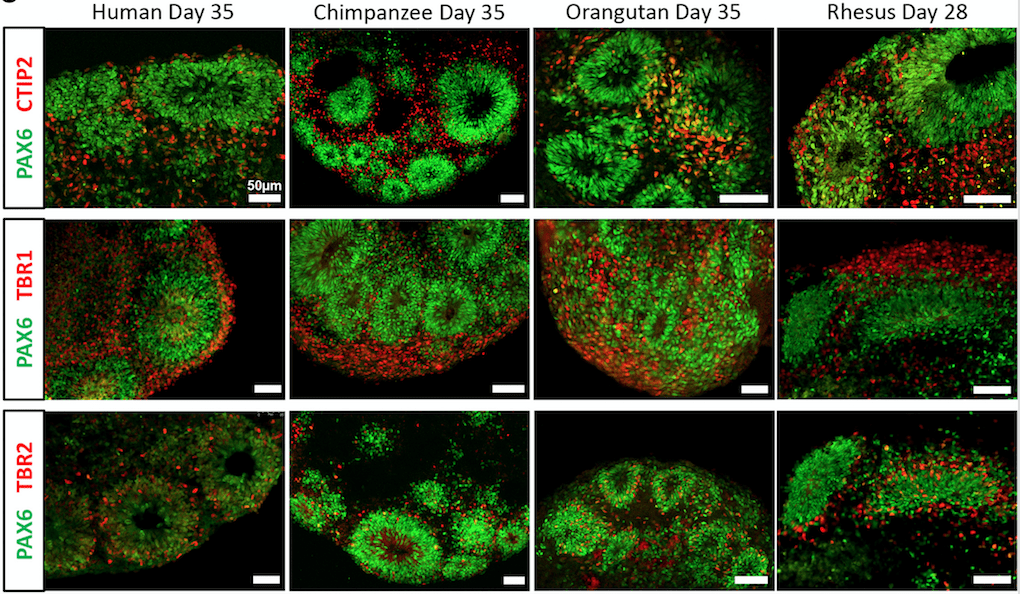SANTA CRUZ, CA – January 10, 2019 Investigators at the UC Santa Cruz Genomics Institute and UCSC Institute for the Biology of Stem Cells are helping complete the picture of what makes us human. They hope that their latest research that looks closely at our brains and compares its evolution to that of other primates, including apes and monkeys — will provide the basis for important insights underlying brain development.
Their latest paper detailing human and primate brain development at a molecular level was published January 10, 2019 by Stem Cell Reports. Their analysis identified four genes shared by humans and primates that are associated with brain development.
Their research builds on results published last May in the journal Cell that showed that a gene only found in humans has influenced our large brain size.
Lead author, former UC Santa Cruz Graduate Student Researcher and California Institute for Regenerative Medicine (CIRM) Fellow Dr. Andrew Field, is currently a Postdoctoral Scholar at Dr. Karen Adelman’s lab at Harvard Medical School, Boston, MA. Dr. Field explained that his research team was motivated to pursue its work because we’ve concluded that our brain size and complexity makes humans unique, but it’s been difficult to explain how exactly our brains got this way.
To help clarify how, Dr. Field and his team at UC Santa Cruz developed organoid models — patches of brain tissues grown from from human, chimpanzee, orangutan, and rhesus monkey pluripotent stem cells. As the brain tissue grew in the lab, the team sampled and analyzed the gene expression at regular intervals. This was an opportunity to develop a snapshot of human and primate brain evolution in action, zooming in beyond even can be seen through a microscope.
This research focused on one class of gene regulatory element, long non-coding RNAs (lncRNAs). While it is known that some lncRNAs can have diverse roles in gene regulation, most human lncRNAs have undetermined function. This study revealed almost 2500 lncRNAs expressed in organoids in human and at least one other primate. They focused on a set of 386 lncRNAs whose expression is dynamic during the organoid assays and found that these transiently expressed, “TrEx” lncRNAs tend to be expressed in specific cell types as determined by single cell RNA sequences.
Field was able to probe the function of four of these TrEx lncRNAs and found evidence that all regulate neural gene expression in various ways. These results suggest lncRNAs may have a role in gene regulation during brain development. However, there is still much unknown about the role lncRNAs play in our genetics. “LncRNA have generated a lot of excitement because of their cell type-specific expression patterns, but difficulties in describing functional roles for them has tempered that enthusiasm. So it was especially satisfying when Andrew found clear evidence that all of the new primate lncRNAs he tested had clear effects on brain gene regulation,” says senior author Sofie Salama.
The authors hope that their data will be used by others to build on their findings. “The data generated in this study provides a valuable resource for comparative studies aimed at understanding human, chimpanzee, orangutan, and rhesus brain development,” said Dr. Field.
This study is part of a larger collaboration between neuroscience faculty at UC San Francisco, Alexander Pollen and Tomasz Nowakowski, and engineering faculty at UC Santa Cruz including senior authors of this study, Sofie Salama and David Haussler as well as Electrical and Computer Engineering faculty, Mircea Teodorescu — an ambitious project to learn how the human brain evolved and how its neural circuitry develops. Funded by a $10 million grant from Schmidt Futures, UC investigators are applying modern artificial intelligence (AI) approaches to understanding and emulating the architecture of the human brain.
“There’s really no more exciting scientific question that I can think of than discovering and decoding the mysterious genetic changes that made us who we are,” says David Haussler, co-senior author and a bioinformatician at the Baskin School of Engineering, University of California, Santa Cruz, a Howard Hughes Medical Institute (HHMI) investigator and member of the Center for the Molecular Biology of RNA at UC Santa Cruz.
The publication, “Structurally conserved primate lncRNAs are transiently expressed during human cortical differentiation and influence cell-type-specific genes,” was co-authored by Andrew R. Field, Frank M. J. Jacobs, Ian T. Fiddes, Alex P. R. Phillips, Andrea M. Reyes-Ortiz, Erin LaMontagne, Lila Whitehead, Vincent Meng, Jimi L. Rosenkrantz, Mari Olsen, Max Hauessler, Sol Katzman, Sofie R. Salama, and David Haussler.
Visit the UCSC Browser companion track hub to see the publication data on the human, chimp, orangutan, rhesus assembly browsers.


Recent Comments